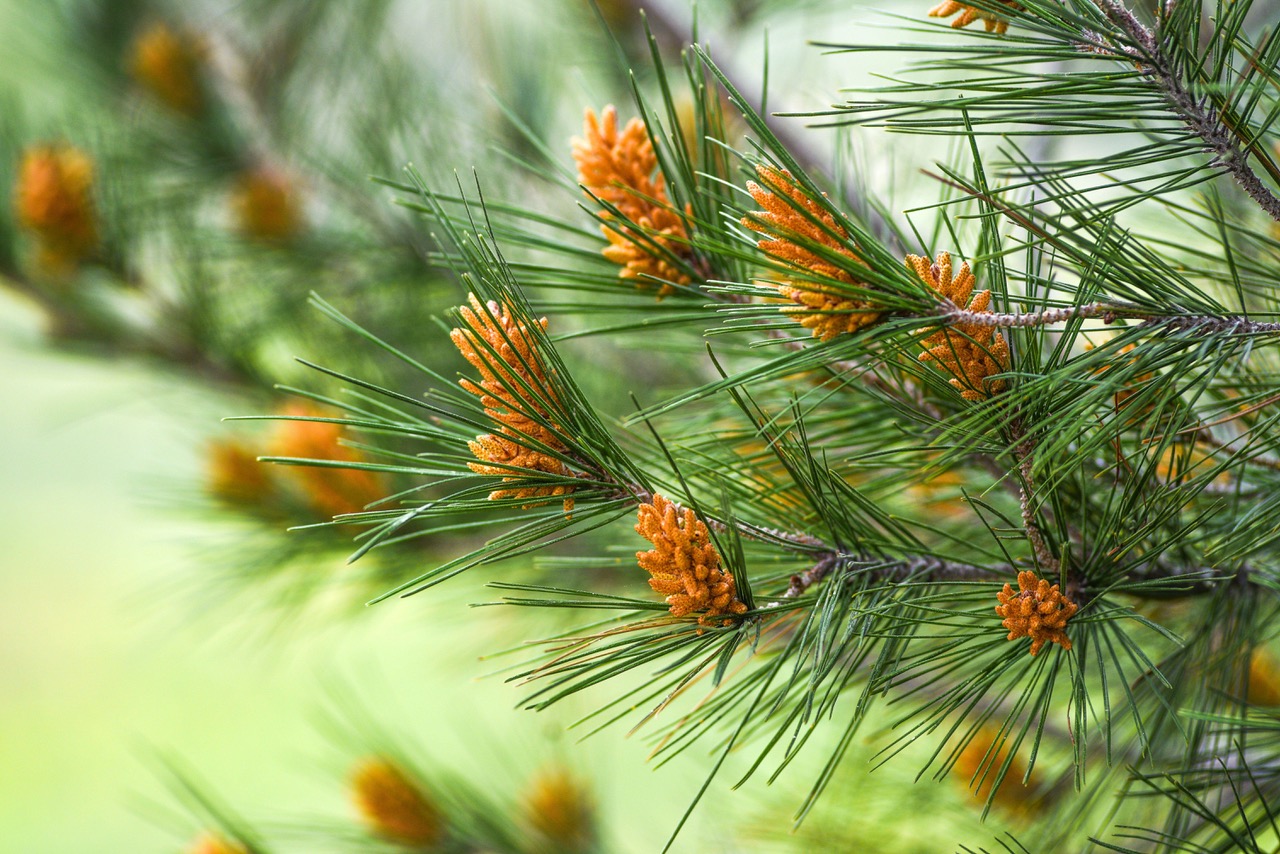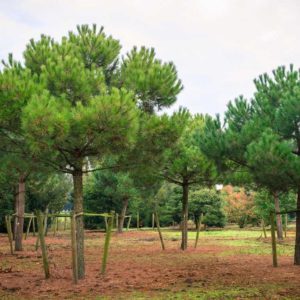Pinus radiata
Price range: €350.00 through €480.00
Frequently Bought Together


Description
Quick Facts
- Common Name: Monterey Pine, Radiata Pine, Insignis Pine
- Botanical Name: Pinus radiata (syn. Pinus insignis)
- Plant Type: Evergreen conifer tree
- Mature Height: 25-40m (can be larger in ideal conditions)
- Mature Spread: 8-12m
- Flowering Period: Spring (insignificant flowers)
- Flower Colour: N/A (grown for foliage and form)
- Foliage: Bright green needles in clusters of three, year-round evergreen
- Hardiness: RHS H4 (hardy in most of UK and Ireland, best in milder coastal areas)
- Soil Requirements: Well-drained soil; tolerates poor, sandy, and acidic soils
- Aspect: Full sun
- Maintenance: Low
Description
Experience the breathtaking beauty of Pinus radiata, one of the fastest-growing and most vigorous evergreen conifers for creating rapid screening, windbreaks, and dramatic vertical presence in gardens and landscapes, where exceptionally fast growth, bright green needles, and impressive stature combine to transform spaces within just a few years and bring year-round structure, shelter, and Mediterranean character to coastal gardens, estates, and anywhere substantial evergreen presence is desired. This exceptional tree offers remarkable qualities—exceptionally fast vigorous growth adding 60-100cm or more annually once established making it one of the fastest-growing conifers available and perfect for creating rapid impact and screening, bright fresh green needles measuring 10-15cm long arranged in clusters of three creating lush dense foliage and vibrant year-round colour that brings life and warmth to winter landscapes, impressive pyramidal to columnar form when young developing into broad domed crown with age creating substantial presence and architectural silhouette, outstanding coastal tolerance withstanding salt spray, maritime winds, and sandy soils making it perfect for seaside gardens and exposed coastal positions where many conifers struggle, and remarkable adaptability thriving in poor soils including sandy, acidic, and nutrient-poor conditions where other trees fail, making this one of the most vigorous and practical choices for adding rapid evergreen screening, windbreak protection, and substantial presence to coastal gardens, estates, shelter belts, and anywhere fast-growing evergreen structure is needed to create privacy, shelter, and year-round impact.
Throughout the seasons, this captivating tree displays its characteristic bright green needles—each needle measures 10-15cm long and is arranged in clusters (fascicles) of three creating dense tufted appearance at branch tips. The needles are bright fresh green to grass-green, more vibrant and lighter than many darker conifers, bringing warmth and life to the landscape particularly noticeable in winter when the bright colour stands out against grey skies and darker evergreens. The needles are slender, flexible, and slightly twisted creating soft texture and graceful movement in breezes. Young trees develop elegant pyramidal to narrowly conical form with strong central leader and regular whorls of horizontal branches creating formal symmetry and architectural presence. As trees mature (typically after 20-30 years), the form broadens and the crown becomes more domed and irregular with massive spreading branches creating substantial presence and character—mature specimens develop impressive girth and rugged bark. The bark on young trees is smooth grey-brown, becoming deeply fissured and ridged with age developing thick corky texture in shades of reddish-brown to dark grey creating sculptural interest. In spring, male flowers (catkins) produce abundant yellow pollen, while female flowers develop into distinctive egg-shaped cones measuring 7-14cm long that persist on branches for many years—these asymmetric cones are tightly closed and remain attached even after seeds are released, creating characteristic clusters along branches. The overall effect is vigorous, substantial, and Mediterranean—like having a piece of California coastline thriving in your garden. The exceptionally fast growth and dense foliage make this outstanding for rapid screening and windbreak establishment.
Native to a very limited natural range along the central California coast near Monterey (hence the common name), plus two small populations on offshore islands, Pinus radiata is one of the world’s most important forestry trees despite its restricted wild distribution—it has been planted extensively worldwide for timber production due to its exceptional fast growth and adaptability. The species name ‘radiata’ refers to the radiate pattern of scales on the cones. In its native habitat, the tree is considered vulnerable due to limited distribution, but in cultivation it thrives and has naturalized in many temperate regions including New Zealand, Australia, Chile, and South Africa where it’s a major forestry species. Introduced to Europe in the 1830s, it quickly became valued for shelter belts, coastal plantings, and ornamental use in estates and large gardens. Hardy to RHS H4, this tree thrives best in milder coastal areas and southern/western regions, though tolerates cold inland areas with shelter—young trees can be damaged by severe frosts below -15°C, but established trees are remarkably hardy. Exceptionally fast growth rate, adding 60-100cm annually (sometimes more in ideal conditions), reaching 10-15m within just 10-15 years—this is one of the fastest ways to establish substantial evergreen presence and screening. Particularly valuable for outstanding coastal tolerance—thrives in exposed seaside positions withstanding salt spray, maritime winds, and sandy soils better than most conifers, making it perfect for coastal windbreaks and shelter belts. Also tolerates poor soils including acidic, sandy, and nutrient-poor conditions, urban pollution, and exposed positions. The bright green foliage provides year-round colour and structure, and the dense growth creates excellent screening and wildlife habitat.
Create stunning compositions by planting as fast-growing windbreak or shelter belt where its exceptional growth rate and dense foliage quickly establish protection from prevailing winds and create sheltered microclimates for other plantings, using for rapid screening and privacy where its vigorous growth provides year-round evergreen barrier within just a few years, or positioning in coastal gardens where its outstanding salt tolerance and wind resistance excel and substantial presence creates structure and shelter. Exceptional in large gardens and estates where its impressive size and fast growth fit the scale and create dramatic vertical presence and Mediterranean character, as background planting in mixed borders where its bright green foliage provides year-round backdrop for deciduous trees and seasonal plantings, or in forestry and farm plantings where its fast growth and timber value make it practical and profitable. Works beautifully planted in groups or rows for windbreaks and shelter belts creating continuous protection, as single specimens in large lawns where trees have room to develop full impressive form, or combined with other coastal-tolerant plants (Escallonia, Griselinia, Pittosporum, Olearia) for layered coastal plantings. Also magnificent in Mediterranean-style gardens where its bright green colour and California origins fit perfectly with the aesthetic, or as nurse trees providing shelter for slower-growing specimen trees and shrubs during establishment. Perfect for adding rapid evergreen screening, windbreak protection, and substantial presence to coastal gardens, estates, shelter belts, and anywhere fast-growing evergreen structure is needed to create privacy, shelter, and year-round impact within just a few years.
Caragh Garden Notebook
Planting: Space trees 3-5m apart for windbreak or screening plantings where trees will grow together creating continuous barrier, or 10-15m apart for individual specimens allowing room for mature spread. Plant container-grown specimens year-round, though autumn (September-November) or spring (March-May) is ideal for best establishment. Choose position in full sun—requires open sunny position for best growth and will not thrive in shade. Thrives in exposed positions including coastal sites with salt spray and strong winds—this is one of the best conifers for challenging exposed positions. Dig generous planting hole twice width of root ball and same depth. This tree tolerates and even prefers poor soils, so minimal soil improvement is needed—avoid over-enriching soil which can cause soft growth susceptible to wind damage. Plant at same depth as in container—avoid planting too deeply. Backfill with excavated soil, firming gently. Water thoroughly after planting. Apply 5cm mulch of bark or gravel around base, keeping mulch clear of trunk. Stake young trees in exposed positions using single stake or guy wires for first 2-3 years until established—this is particularly important in coastal and windy sites. Water regularly during first growing season to establish root system, though established trees are remarkably drought-tolerant. Position where the tree has room to grow—this is a large vigorous tree unsuitable for small gardens or near buildings.
Soil Preparation: Tolerates remarkably wide range of soil types including sandy, loamy, clay, acidic, and nutrient-poor soils—this is one of the most adaptable conifers for challenging soil conditions. Prefers slightly acidic to neutral pH (5.5-7.0) but tolerates more acidic conditions. CRITICAL: Requires well-drained soil—avoid waterlogged or poorly drained soils which cause root rot and poor establishment. Thrives in poor sandy soils including coastal sand dunes where many trees fail—the tree naturally grows in nutrient-poor sandy soils in its native California habitat. Does not require fertile soil and actually prefers lean conditions which produce stronger wood and better wind resistance—avoid over-fertilizing which causes soft growth. Tolerates drought once established—deep watering during establishment is important, but mature trees require minimal watering. Mulch lightly with bark or gravel to suppress weeds, but avoid thick organic mulches which can cause collar rot. Best growth occurs in full sun with well-drained soil (even poor or sandy) and exposure to wind which produces stronger wood and more compact growth.
Container Growing: Not suitable for container growing due to exceptionally fast growth, large mature size, and vigorous root system—this is a substantial forest tree requiring in-ground planting. Young seedlings can be grown in containers for 1-2 years before requiring permanent planting, but will quickly become pot-bound and stressed. Plan for permanent in-ground planting in suitable location with room for mature size.
Seasonal Care: Requires minimal pruning—the naturally pyramidal form when young develops without intervention. Avoid pruning mature trees as Pinus species do not regenerate from old wood—cutting back into bare branches will leave permanent gaps. Can remove lower branches gradually over several years to create clear trunk if desired, but avoid removing too much in one year which stresses tree. Remove dead, damaged, or diseased branches as needed. Young trees can be lightly shaped by removing competing leaders to maintain single central leader, or by pinching (breaking off by hand) half the length of new spring growth (candles) before needles fully expand to create denser more compact growth—this technique is useful for windbreak plantings. Apply general-purpose fertiliser in spring only if growing in extremely poor soil, though this is rarely necessary—lean conditions produce stronger growth. Avoid over-fertilizing which causes soft growth susceptible to wind damage and disease. Water during prolonged drought in first 3-5 years of establishment, though mature trees are remarkably drought-tolerant. Watch for pine processionary moth caterpillars in warmer regions (remove nests in winter), Dothistroma needle blight (brown needle tips—remove affected branches), and pine shoot beetle (rare in UK). Generally pest and disease free with good air circulation and appropriate positioning. The exceptionally fast growth creates rapid impact and screening!
Propagation: Easily grown from seed—collect cones in autumn/winter, extract seeds, and sow in spring in free-draining compost. Germination occurs within 2-4 weeks. Grow seedlings in containers for 1-2 years before planting out. Seedlings grow very rapidly. Cannot be propagated from cuttings. Home gardeners can easily grow from seed, though nursery-grown specimens provide more immediate impact and guaranteed quality.
This spectacular beauty is absolutely breathtaking—one of the fastest-growing evergreen conifers available! That exceptionally fast vigorous growth adding 60-100cm or more annually is absolutely stunning—creating rapid screening and substantial presence within just a few years! Bright fresh green needles in clusters of three bringing vibrant year-round colour, impressive pyramidal form when young developing into broad domed crown with age reaching 25-40m tall. Outstanding coastal tolerance—thrives in exposed seaside positions withstanding salt spray and maritime winds better than most conifers! Remarkable adaptability—tolerates poor sandy acidic soils where other trees fail. Hardy (RHS H4) in most areas, best in milder coastal regions. Perfect for rapid windbreaks, screening, coastal gardens, estates, shelter belts, and anywhere you need fast-growing evergreen structure and protection. IMPORTANT: This is a large vigorous tree unsuitable for small gardens—needs space to develop! Perfect for creating privacy, shelter, and year-round impact within just a few years. Pure vigorous magnificence and rapid coastal screening!





